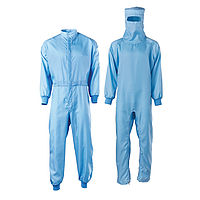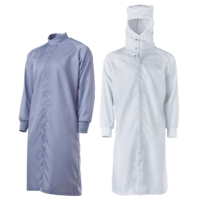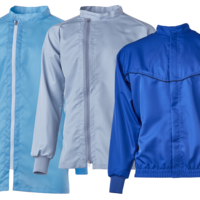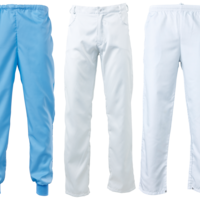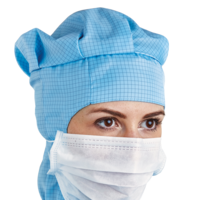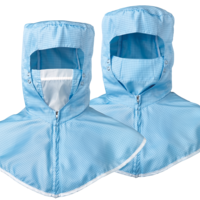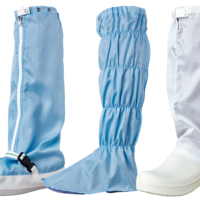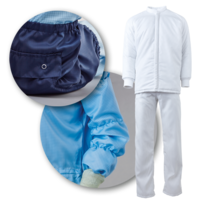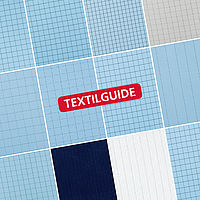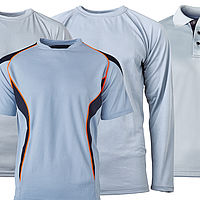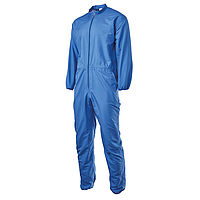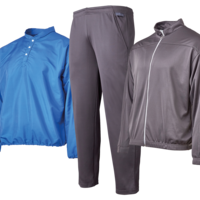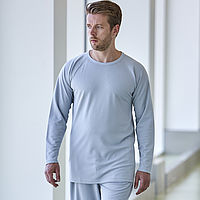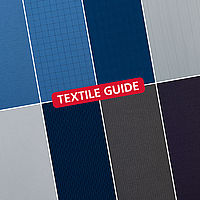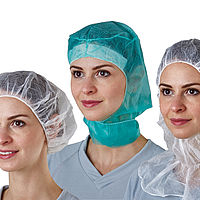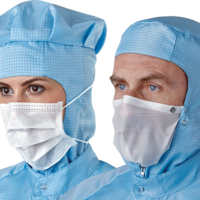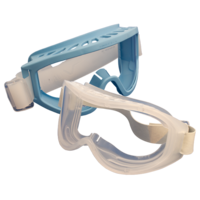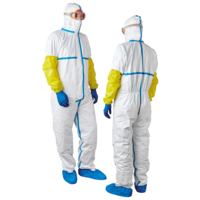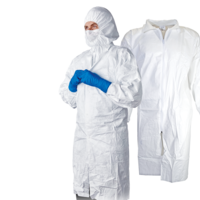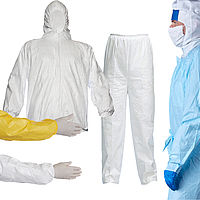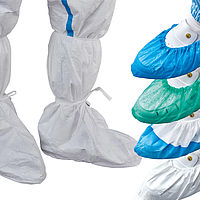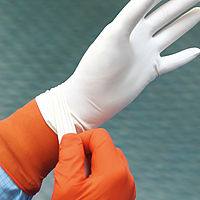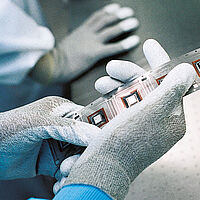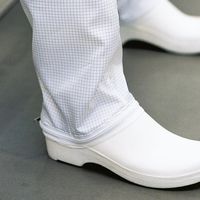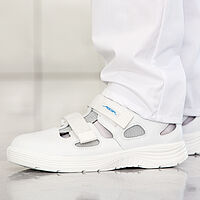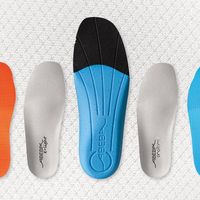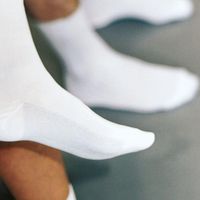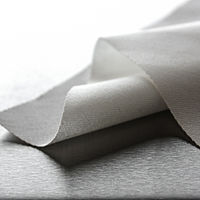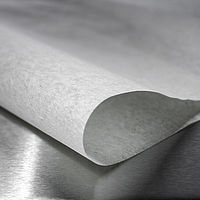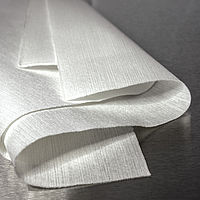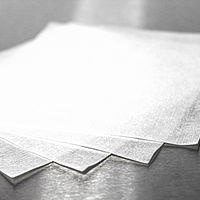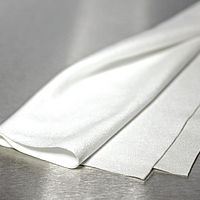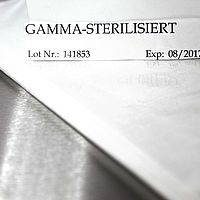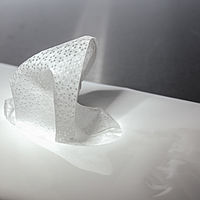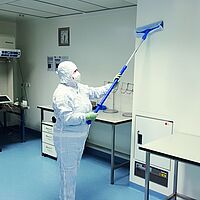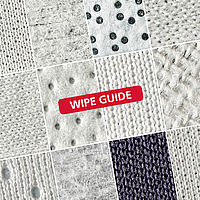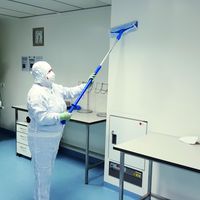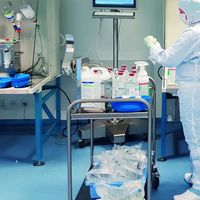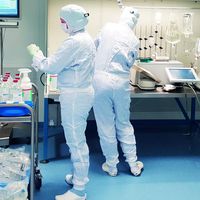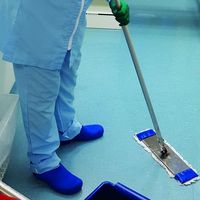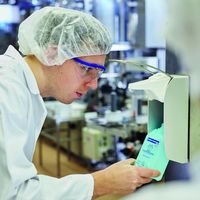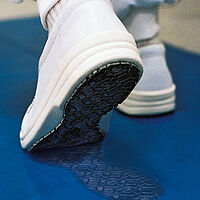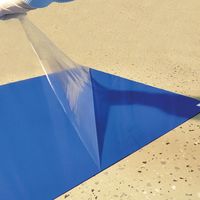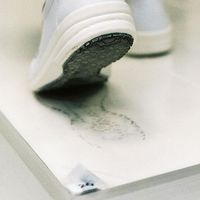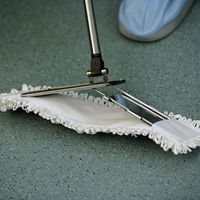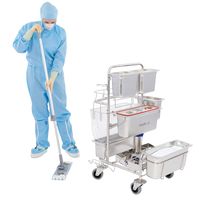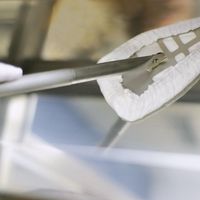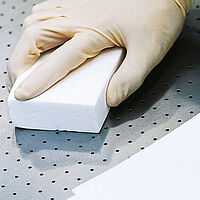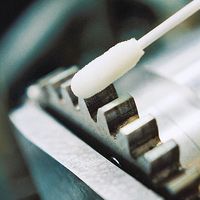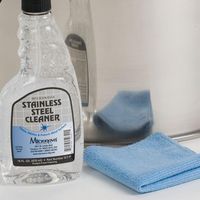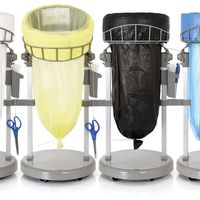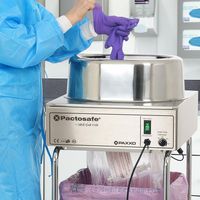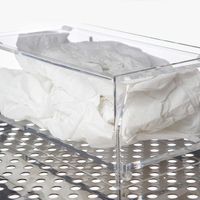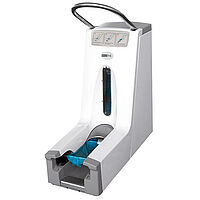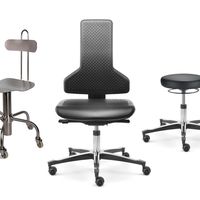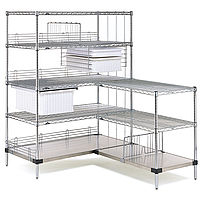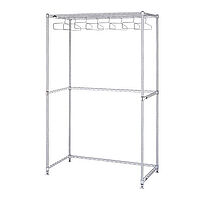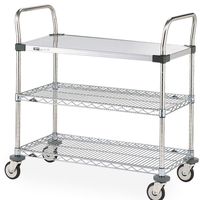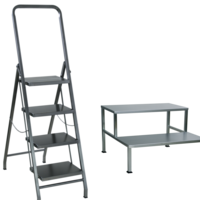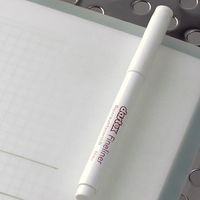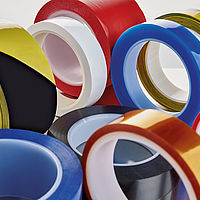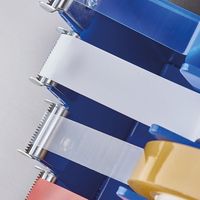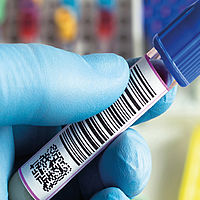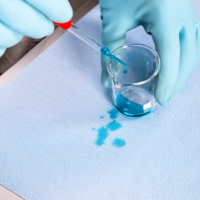| A | abrasion resistance and roughening tendency (ageing signs) | Determination of the abrasion resistance of textile fabrics using the Martindale method according to ISO 12947; enables conclusions about the self-contamination by textile particles. |
| absorption | Absorption capacity of liquids of a textile fabric by capillary action, combined with its retention capacity, per unit time. | |
| adhesion | The sticking of molecules to an interfacial surface. | |
| aerosol | Fine dispersed solid or liquid floating particles in a gas/gas mixture. Here: aerosol spray in a can from the IPA & WFI product range and denatured ethanol & WFI (pressure gas package). | |
| ambidextrous | Concerning gloves: suitable for both hands; no left or right shape has been assigned, so wearing on either hand is possible. | |
| antiseptic | Microbial count reducing agent, usually to achieve disinfection. | |
| AQL | Concerning gloves: see EN 455 Medical gloves for single use – Part 1: Requirements and testing for freedom from holes; the Acceptable Quality Limit coefficient defines the maximum number of gloves tested in a batch that may have pinholes so that the entire batch is not rejected as unfit for sale. | |
| area disinfection | Disinfection of inanimate areas and equipment. | |
| autoclaving | Sterilisation in a steam autoclave using water vapour at temperatures between + 110 °C to + 140 °C (230 °F to 284 °F). | |
| B | bactericide | A single active substance or mixture that kills the proliferation of bacteria. |
| biocide | Biocidal products are liable to regulation (EU) No. 528/2012 concerning the making available on the market and use of biocidal products, defined as "any substance or mixture, in the form in which it is supplied to the user, consisting of, containing or generating one or more active substances, with the intention of destroying, deterring, rendering harmless, preventing the action of, or otherwise exerting a controlling effect on, any harmful organism by any means other than mere physical or mechanical action" (extract Article 3). | |
| Body-Box | An indispensable test cabin for testing the effectiveness of cleanroom fabrics under real environmental conditions. | |
| breathability | After determining the water vapour permeability of the textile, its breathability is assessed. | |
| bulk-packed | Loosely packed: not folded, not stacked or single packed; opposite of flat-packed. | |
| C | cellulose (CEL) | Main component of plant cell walls or fibres, e.g. in tree trunks or cotton bolls used for paper/cardboard production or fabrics, e.g. viscose (rayon). |
| certificate of analysis (CoA) | Part of documentation for sterile products, e.g. disinfectants, gloves, wipes etc., to furnish proof that the products conform to the requested requirements. | |
| certificate of conformance (CoC) | Certificate of conformity of a product with certain specifications; not to be confused with an EC type-examination certificate. | |
| certificate of irradiation (CoI) | Certificate attesting that a product has been irradiated under certain conditions (e.g. validated procedure). | |
| certificate of sterility (CoS) | Certificate attesting that a product has a guaranteed sterility. It is usually valid for a certain time frame, which is noted on the product packaging/certificate. | |
| cleaning | Removal of visible and non-visible dirt, contaminants, organic and inorganic material. This prevents amongst others microorganisms to proliferate therein. | |
| contamination | The deliberate or unintentional contamination of an object during its extraction, manufacture, processing, preparation, treatment, presentation, packaging, transport and storage. This may include dust, micro-organisms, residues of equipment or harmful substances. | |
| continuous filament | A fibre of theoretically unlimited length, produced by various chemical-technical processes as a component of yarns, is often called a continuous or endless filament; this includes synthetic fibres that are not cut to a specific length, but also natural silk. | |
| cotton | Natural fibre obtained from the long seed hairs of the cotton plant, but short stapled compared to synthetic continuous fibres (filaments). The fibres are used for the production of yarns, fabrics and knitwear. | |
| chlorinated polyethylene (CPE or PE-C) | A thermoplastic polymer which is very often used in the textile industry for its (water) tightness and tear resistance. Other meaning: (pressure) cast polyethylene, which is applied over a fabric to make it also waterproof and tear-resistant. | |
| cytostatic drugs | Substances that inhibit cell growth or cell division, especially of malignant tumour cells. |
| D | decontamination | Removal of contaminants and residues by mechanical, physical, chemical, biological, radiological means (see contamination). |
| deionised water (DI water) | Water that has been freed from dissolved and undissolved substances by certain processes using ion exchangers or reverse osmosis systems. This water is characterised by its low conductivity and its absence of residues. | |
| denier (den) | Non-standard measuring unit for yarn thickness (weight by unit of length); 1 den = 1 gram per 9,000 meters (see tex). | |
| derivative | Material with a structure similar to that of the corresponding basic substance. | |
| disinfection | Killing/inactivating of pathogens such as bacteria, fungi or viruses to prevent infections. | |
| disinfection plan |
Disinfection plans are part of the hygiene plan. The disinfection plan specifies details of disinfection measures: what? when? with what? how? how often? who? | |
| E | efficiency | Efficacy in relation to the time required and the cost-effectiveness. |
| electron beam radiation | Electron irradiation or E-beam processing is a process using beta radiation to sterilise here primarily pharmaceutical or medical goods. | |
| electrostatic features | In addition to conductivity, the disposition to electric charge and discharging rate are particularly considered here. | |
| endotoxins | Decomposition products of bacteria; belong to the bacterial pyrogens. | |
| enveloped viruses | Viruses which have a viral membrane envelope as outer layer. | |
| EPA | Electrostatic protected area, in which electrostatic charges, which often arise from frictional electricity, are prevented by antistatic equipment. This serves to protect against electrostatic discharge (ESD), which can damage or destroy sensitive electronic components and to ensure the maximum permissible electrostatic charges to the human body. | |
| ESD | Electrostatic discharge: a voltage breakdown caused by a large potential difference. These breakdowns (possibly visible as sparks) cause a short, high electric current and can lead to the ignition of flammable substances. Under unfavourable circumstances, fire and explosion hazards as well as hazards to persons due to electric shock may occur. Other undesirable consequences of electrostatic discharges are damage to electrical components in equipment. | |
| EtO (EO-sterilisation) | Chemical sterilisation process using ethylene oxide gas, which inactivates the DNA of microorganisms, even under air-permeable packaging. | |
| F | fabric | Textile area-measured material consisting of at least two crossed thread or yarn systems. The threads in the longitudinal direction are called warp threads (warp), the transverse threads are called weft threads (weft). The threads crossing each other regularly (this is called weave type) thus enable a relatively firm structure. |
| feel (of a textile surface) | Characteristics that are detected by the sense of touch. The handle of a textile. An often very subjective haptic perception and assessment of whether a garment/textile feels comfortable or is more likely to be classified as unpleasant. | |
| filament yarn | Filament yarn is theoretically made out of endlessly long fibres called filaments. Filament yarns do not have to be twisted as they hold together anyway. They are often texturised. | |
| flat-packed | Also: stapled, opposite to bulk-packed. | |
| fungicide | Single active ingredient or mixture that kills fungi. | |
| G | gamma sterilisation | Sterilisation method using gamma radiation (unit name/symbol: Gray/Gy). |
| gauze | Net-like, lightweight textile. | |
| GMP/CGMP GMP | Good Manufacturing Practice, see Commission Regulation (EC) No 2023/2006 of 22 December 2006 on good manufacturing practice for materials and articles intended to come into contact with food (Text with EEA relevance). | |
| CGMP | Current Good Manufacturing Practice Regulations, see Food and Drug Administration (USA). FDA's portion of the Code of Federal Regulations (CFR) is in Title 21 which interprets the Federal Food, Drug and Cosmetic Act and related statutes, including the Public Health Service Act. |
| H | hand disinfection | Targeted deactivation and killing of pathogenic germs on hands. |
| hand specific | In the case of gloves: they are manufactured specific to the left or the right hand. | |
| HEPA-filter | High Efficiency Particulate Air Filter | |
| hydro-entangled | Here: textile fibres are firmly bonded together on a movable sieve grate to form a flat structure (non-woven fabric) by water jets which impinge on the fibres under high pressure from a large number of micro-nozzles. | |
| hygiene | According to the definition of the German Society for Hygiene & Microbiology, hygiene is the teaching of the avoidance of sickness and the upholding and consolidation of health. | |
| I | ionic load | Concerning gloves: contamination caused by the metallic or chemical production residues. |
| isopropanol (IPA) | Also isopropyl alcohol or Propan-2-ol, a flammable solvent with strong degreasing and disinfecting properties. | |
| K | knit/knitted fabric | Textile area-measured product consisting of knitted or crocheted fabrics obtained by means of one or more threads or yarns using at least two needles. Knitted fabrics are generally more elastic than woven fabrics. |
| L | laser-sealed | The cloth edges were sealed during laser cutting. |
| latex | Natural rubber. Highly elastic, but not very resistant to chemicals. Potentially allergenic if not properly decontaminated. | |
| levurocide | Single active substance or mixture that kills yeast (e. g. Candida albicans). | |
| M | medical products | Are essentially instruments and substances to diagnose, prevent, treat and relieve illnesses and disabilities of humans. The exact definition can be found in § 3 of the German Medical Devices Act (Medizinproduktgesetz – MPG). |
| microfibre | The fineness of such a fibre is less than 1 dtex; i.e. 10,000 m of a microfiber weigh <1 g. Microfibre fabrics are very soft and retain their shape. | |
| microporous film | Here: generally a polyethylene film (PE as a barrier layer) with microscopic apertures ("pores"), which is applied to a carrier material made of spunbonded fabric. The film thickness is approx. 0.02 mm and has a very low abrasion resistance. | |
| N | nitrile | Chemical very stable compound with latex rubber like characteristics. |
| non-enveloped viruses | Viruses that do not have a membrane envelope, e.g. noro- or rotaviruses. Non-enveloped viruses are comparatively more stable against disinfectants than enveloped viruses. | |
| non-woven | Fibres of limited length, endless fibres (filament yarns) or cut yarns of any kind which are oriented or randomly joined to form a fibre layer (e.g. mechanically, thermally, by water jet, by applying film-forming bonding agents based on aqueous dispersions). | |
| NVR | Non-volatile residues | |
| nylon | Trade name for synthetic fibre made from polyamide (PA 6.6). |
| P | particle migration behaviour | Particles and fibres released by frictional movements move through the textile due to mechanical forces. |
| particle retention | Filtration efficiency against airborne particles. | |
| penetration | Concerning gloves: passage of solid, liquid or gaseous substances through macroscopic holes (defects, seams). | |
| permeation | Concerning gloves: passage of solid, liquid or gaseous substances in the molecular range. | |
| personal protective equipment (PPE) | Items such as clothing designed to protect the wearer against risks arising from the working environment. | |
| plain weave | These fabrics show the same fabric appearance on the upper and lower fabric side; each warp thread alternately crosses a weft thread; see also twill weave. | |
| polyamide (PA) | Synthetic, thermoplastic polymer (like nylon) with good chemical resistance to organic solvents, but easily decomposable by acids and oxidizing chemicals. | |
| polycarbonate (PC) | Synthetic thermoplastic polymer which are characterised by high strength, impact resistance, stiffness and hardness. Polycarbonates are resistant to water, many mineral acids and aqueous solutions of neutral salts and oxidising agents. | |
| polychloroprene (CR) | A synthetic rubber (chlorobutadiene rubber); highly elastic and tear-resistant with a high chemical resistance, also known as neoprene. | |
| polymer | Natural as well as man-made chemical compound, consisting of many more or less identical macromolecules. | |
| polypropylene (PP) | Semi-crystalline thermoplastic belonging to the polyolefins and used as a raw material for man-made fibres. | |
| polyurethane (PU) | Thermoplastic polymer; also used as a coating material for textiles or shoe sole. | |
| polyvinylalcohol (PVAL) | Thermoplastic polymer; resistant to many water-free organic solvents. | |
| polyvinylchloride (PVC) | Synthetic thermoplastic polymer made as required soft and formable or hard due to the addition of softeners/hardeners and stabilisers. Also called vinyl. | |
| pre-preparation | Concerning controlled areas: for cleaning and disinfectant purposes impregnated cleaning textiles which can be used immediate to avoid mixing of solutions and the squeezing of wipes and mops. | |
| PU | Purchasing unit | |
| purified water (PW) | Treated water according ISO 22519:2019-06. | |
| pyrogen | Inflammatory/fever-inducing agent. | |
| R | rayon | Name for viscose fibres, which are chemical fibres (regenerated fibres) made of regenerated cellulose, which can be produced as filament yarn or as spun fibre. They are generally less linting and more absorbent than cotton or similar cellulose fibres. |
| S | safety data sheet (SDS) | Also known as material safety data sheets (MSDS), are used to transmit safety-related information on substances and mixtures. They are intended to provide professional users with the necessary data and handling recommendations for handling substances and mixtures in order to be able to take the necessary measures for health protection, safety at work and environmental protection. |
| sealed edges | The edges of a fabric are sealed when the wipes are cut to size. Sealing can be achieved as follows: by laser, by ultrasound, by hot wire/blade. | |
| SMS | 3-layer non-woven fabric. Inner and outer layer made from spunbonded fabric and the middle layer is made from meltblown fabric. | |
| special accessories/special options | Dastex' cleanroom garments are devised using the modular design principle. Standard models are defined (a sort of basic scaffolding) which, depending on customer requirements, can be extended with additional options (special accessories). Examples: bags, loops, knitted cuffs, logos etc. | |
| sporicide | Single active substance or mixture that kills spores. | |
| sterilisation | Germicidal process by which the materials and articles are freed from living microorganisms of any form (e.g. bacteria, fungi, viruses) including their dormant stages (e.g. spores). | |
| suspended solid | In a liquid or gas suspended, finely spread compound. | |
| T | textile equipment | Garments can be additionally equipped at the end of the manufacturing chain with defined surface finishes, thus to achieve a certain functionality of the fabric. E. g. durable water-repellent equipment and antimicrobial equipment. |
| textile laminate | Multi-layer flexible surface fabric containing at least one textile (woven, knitted, non-woven) Lamination produces a strong fabric, known for its use as a climate fabric in functional clothing. | |
| texturing (or structuring) |
Concerning gloves: application of a profile level with the fingertips and/or palms with the aim to increase grip. Concerning textiles: process of giving smooth filament yarns a structure (texture). The aim is to improve the textile properties of smooth synthetic fibres made of polyamide, polyester or polypropylene, e.g. elasticity, volume, increased moisture absorption, better moisture transport, better air inclusion, reduced gloss and a more pleasant feel or wearer comfort. | |
| thermo-sealed | Edges are sealed with heat, e.g. by a hot wire or a hot blade. | |
| triboelectric behaviour |
The behaviour of electrical charges on plastic surfaces (here synthetic textile surfaces). Describes how susceptible a textile is to becoming charged by friction and how quickly it discharges again. | |
| twill | Also called twill weave, besides the plain weave and the satin weave, one of the three basic bonding types for woven fabric. A distinction is made between warp and weft twill, depending on whether the warp or weft threads are woven on the upper side of the goods predominate. A characteristic feature is the oblique burr. | |
| U | ultrapure water | Differences to DI water are particularly evident in conductivity. Production often takes place in several steps by means of membrane filtration, ultra-fine filtration, UV and ozone systems or ion exchangers. |
| ultrasonic-sealed | Edges are sealed by ultrasound. | |
| V | VAH (Verbund für Angewandte Hygiene e.V.) | This German association for applied hygiene certifies disinfectants and publicises the results and the major information and direction for use in its VAH-Liste. |
| VHP | (a trademark of STERIS Corp.) Also known as hydrogen peroxide vapour, with applications as a low-temperature antimicrobial vapour used to decontaminate enclosed and sealed areas such as laboratory workstations, isolators and air locks. | |
| vinyl | See polyvinylchloride (PVC) | |
| virucide (antiviral agent) | Single active substance or mixture that kills/inactivates viruses (enveloped and non-enveloped viruses). | |
| W | water for injection (WFI) | Ultrapure water, manufactured with reverse osmosis, ultrafiltration or distillation (in the EU with distillation). |






